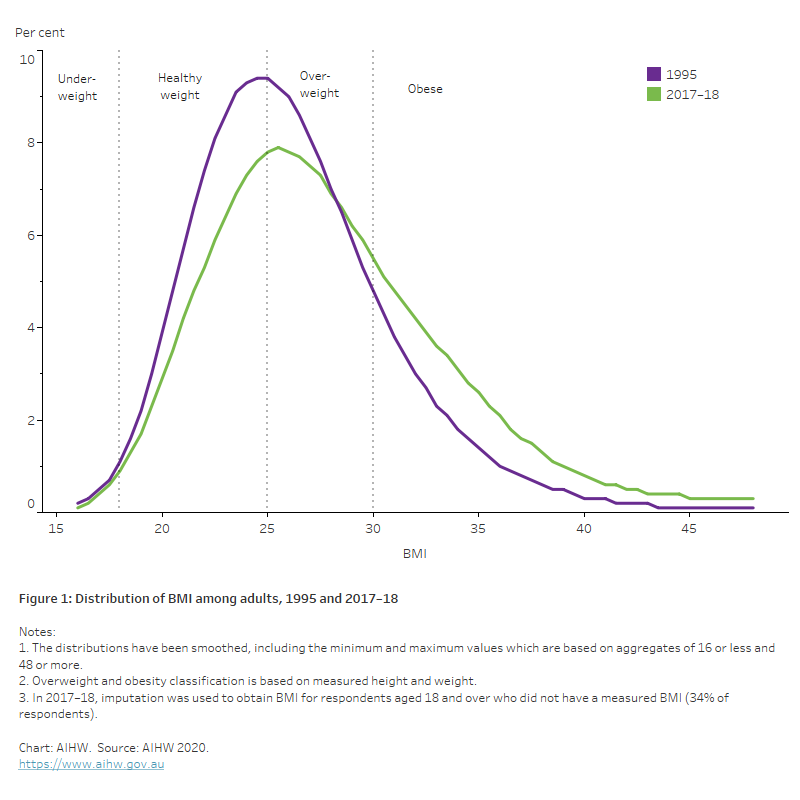Overweight and obesity
In 2017–18, based on the latest available measured data from the 2017–18 Australian Bureau of Statistics (ABS) National Health Survey (NHS):
- An estimated 25% of children and adolescents aged 2–17 were overweight or obese, with 17% overweight but not obese, and 8.2% obese. Rates varied across age groups, but were similar for males and females.
- An estimated 67% of Australians aged 18 and over were overweight or obese (36% overweight but not obese and 31% obese).
- Both overweight and obesity and obesity rates were higher among men than women (1.3 and 1.1 times as likely, respectively).
- Obesity was more common in older age groups – 6% of adults aged 18–24 were obese, compared with 41% of adults aged 65–74 (AIHW 2020).
Overweight and obesity increase the risk of chronic diseases, including heart attack and stroke, and are associated with increased morbidity and mortality. Excess body fat can contribute to the development of biomedical risk factors, raising levels of blood pressure and abnormal blood lipids, and increasing the risk of type 2 diabetes.
Overweight and obesity usually occur because of an imbalance between energy intake from the diet and energy expenditure through physical activities and bodily functions. This energy imbalance is influenced by a complex interplay of individual, environmental and societal determinants (AIHW 2017).
Adults with a body mass index (BMI) (kg/m2) of 25–29 are considered to be overweight, but not obese, while a BMI of 30 or over is classified as obese. A separate classification of overweight and obesity based on age and sex is used for children and adolescents.
After adjusting for different population age structures over time, the prevalence of overweight and obesity among Australians aged 18 and over increased by 16.5% between 1995 and 2017–18 (AIHW 2020) – driven by a 63% increase in obesity rates during this period (Figure 1).
Figure 1: Distribution of BMI among adults, 1995 and 2017–18
The line chart compares the distribution of body mass index in 1995 and 2017–18, and shows that a greater proportion were overweight or obese in 2017–18.

Variation between population groups
After adjusting for different population age structures:
- Adults living in Outer regional and remote areas and in Inner regional areas were 1.1 times more likely to be overweight or obese in 2017–18, compared with people living in Major cities.
- Adults living in the lowest socioeconomic areas were 1.2 times more likely to be overweight or obese than those in the highest socioeconomic areas (AIHW 2020).
- Indigenous Australians aged 15 and over were less likely than non-Indigenous Australians to be overweight but 1.5 times as likely to be obese (AIHW and NIAA 2020).
AIHW (Australian Institute of Health and Welfare) (2017) A picture of overweight and obesity in Australia, AIHW, Australian Government, accessed 15 December 2021.
AIHW (2020), Overweight and obesity: an interactive insight, AIHW, Australian Government, accessed 15 December 2021.
AIHW and NIAA (National Indigenous Australians Agency) (2020) Aboriginal and Torres Strait Islander Health Performance Framework 2020, Measure 2.22 Overweight and obesity, AIHW, Australian Government, accessed 1 December 2021.


